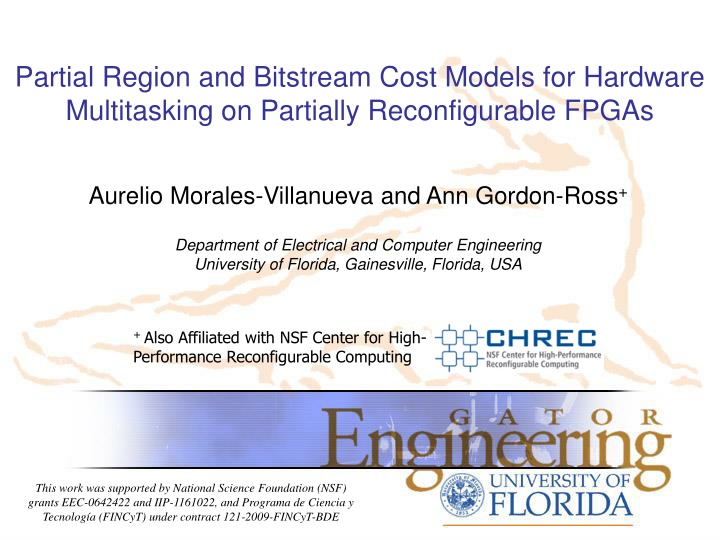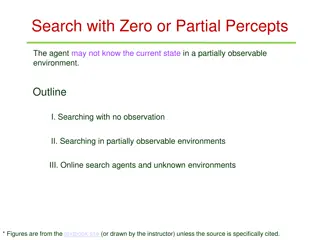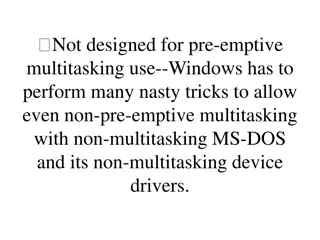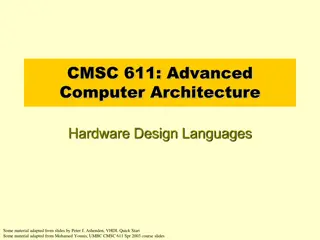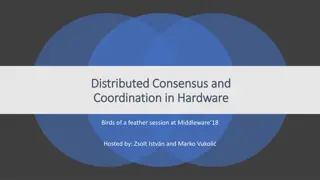Partial Region and Bitstream Cost Models for Hardware Multitasking on Partially Reconfigurable FPGAs
This study presents partial reconfiguration (PR) models for hardware multitasking on partially reconfigurable FPGAs, discussing the benefits, challenges, and comparisons with full reconfiguration. It explores the division of FPGA fabric into static and reconfigurable regions, highlighting the advantages of PR in enabling efficient hardware multitasking, area and power reduction, and faster configuration.
Download Presentation

Please find below an Image/Link to download the presentation.
The content on the website is provided AS IS for your information and personal use only. It may not be sold, licensed, or shared on other websites without obtaining consent from the author.If you encounter any issues during the download, it is possible that the publisher has removed the file from their server.
You are allowed to download the files provided on this website for personal or commercial use, subject to the condition that they are used lawfully. All files are the property of their respective owners.
The content on the website is provided AS IS for your information and personal use only. It may not be sold, licensed, or shared on other websites without obtaining consent from the author.
E N D
Presentation Transcript
Partial Region and Bitstream Cost Models for Hardware Multitasking on Partially Reconfigurable FPGAs Aurelio Morales-Villanueva and Ann Gordon-Ross+ Department of Electrical and Computer Engineering University of Florida, Gainesville, Florida, USA + Also Affiliated with NSF Center for High- Performance Reconfigurable Computing This work was supported by National Science Foundation (NSF) grants EEC-0642422 and IIP-1161022, and Programa de Ciencia y Tecnolog a (FINCyT) under contract 121-2009-FINCyT-BDE
Introduction Field-programmable gate arrays (FPGAs) Programmable devices with large amount of resources Resources connected with a complex, configurable routing network Logic resources: CLBs (LUTs, flip-flops) Special resources: BRAMs, DSPs, hardcore P Reconfiguration on FPGAs Benefits system designers and functionality Run-time hardware adaptation via resource time multiplexing Reduced area/power requirements Two types of reconfiguration: full and partial reconfiguration 2 of 20
Full Reconfiguration Used for initializing the entire FPGA Entire FPGA configured with full bitstream and fixed hardware task set Reconfiguration halts all tasks (i.e., the entire system) Lengthy switching time if task set changes HW task C1 HW task C2 HW task B1 HW task B2 HW task A1 HW task A2 Full bitstream 1 Configuration Port Full bitstream 2 Execution and state of all tasks is lost during full reconfiguration! 3 of 20
Partial Reconfiguration (PR) PR divides the FPGA fabric into two regions Static region: fixed functionality, never reconfigured after initial configuration at startup Reconfigurable region: multiple PR regions (PRRs) PRRs execute PR modules (PRMs) (hardware tasks) Module A ICAP Mem Controller Module B Embedded processor Module C Module D Static region Reconfig. region Current FPGAs support PR Enables efficient hardware multitasking FPGA area and power reduction, faster configuration, etc. Effectively leveraging PR on FPGAs Challenging for system designers Early design decisions affect overall PR system performance Inappropriate decisions severely degrade PR system performance Potentially worse than non-PR system 4 of 20
Partial vs. Full Reconfiguration Dynamic, on-the-fly PR of individual PRRs No execution interruption of static region or other PRRs! Uses partial bitstreams Smaller than full bitstream faster reconfiguration time *May* require bitstream for each PRM-to-PRR mapping Increased flexibility Increased task throughput/performance Reduced FPGA area requirements Reduced power consumption Configuration Overhead Reconfiguration Overhead Function Static region operation Power On Time 5 of 20
System Designer Challenges Critical design decisions done in early system design PRR size/organization? PRR size? How big? PRM-to-PRR mapping? Design partitioning? PRR 1 PRR 1 PRR 1 PRR 1 PRR 1 Static region PRM1 PRM2 PRM3 OR PRR 2 PRR 2 PRR 2 PRM4 Resource utilization vs. PRR size/organization PR partitioning design space is exponentially large Fine-grained to coarse-grained partitioning Simple operations to entire application as a single PRM Designers can only evaluate a subset of these designs Need analytical or simulated cost models Evaluate design decisions impact on PRR size/organization and partial bitstream sizes Cost models avoid lengthy PR design flow 6 of 20
Motivations Prior works in PR cost models Only provided partial methods for evaluating design tradeoffs Manual PRR floorplanning process in the PR design flow Avoid oversized PRRs Avoid ill-suited PRR organizations Goal: high resource utilization per PRR Benefits: Smaller partial bitstreams Faster reconfiguration times Efficent area utilization in the FPGA GOAL: High-level cost models for system designers Evaluation of design decisions early in the design process The cost models must provide sufficiently accurate evaluations Reduces design space exploration time As compared to full system implementation to attain same information change to PRR PRR PRR PRR 7 of 20
Contributions Two high-level cost models for design decision evaluation Based on synthesis report results generated by Xilinx tools PRR size/organization cost model Compares PRRs with different resources and FPGA fabric locations Partial bitstream size cost model Partial bitstream size derivation based on PRR size/organization Benefits of our cost models Early estimation of PRR size/organization and partial bitstream size Increases the resource utilization in PRRs Generally portable across different Xilinx FPGA families Device-specific characteristics values used in cost model formulas Does not require executing the entire PR design flow Significantly decreases the design exploration time Increasing system designer productivity 8 of 20
PRR Size/Organization Cost Model 9 of 20
PRR Size/Organization Cost Model Parameters Parameter DSPcol BRAMreq WBRAM HBRAM BRAMcol CLBavail FFavail DSPavail BRAMavail H W PRRsize Description Parameter LUT_FFreq LUTreq LUT_CLB FF_CLB CLBreq FFreq WCLB HCLB CLBcol DSPreq WDSP HDSP Description DSPs in a column (per row) BRAMs required in PRM BRAM columns in PRR BRAM rows in PRR BRAMs in a column (per row) CLBs available in PRR FFs available in PRR DSPs available in PRR BRAMs available in PRR Number of rows in the PRR Number of columns in the PRR Size of PRR LUT FF pairs required in PRM Slice LUTs required in PRM LUTs per CLB FFs per CLB CLBs required in PRM FFs required in PRM CLB columns in PRR CLB rows in PRR CLBs in a column (per row) DSPs required in PRM DSP columns in PRR DSP rows in PRR Based on Xilinx synthesis report results Parameter CLBcol DSPcol BRAMcol LUT_CLB FF_CLB Virtex-4 16 4 4 8 8 Virtex-5 20 8 4 8 8 Virtex-6 40 16 8 8 16 Specific values in PRR size/organization cost model for Virtex-4, -5, and -6 device families 10 of 20
Derivation of the PRR Size/Organization Extract resources required for PRMs that map to same PRR Selected Device : 5vlx110tff1136-1 Slice Logic Utilization: # of Slice Registers: 1592 of 69120 2% # of Slice LUTs: 1527 of 69120 2% # used as Logic: 1527 of 69120 2% BRAMs Flip-Flops DSPs Slice Logic Distribution: # of LUT Flip Flop pairs used: 2619 # with an unused Flip Flop: 1027 of 2619 39% # with an unused LUT: 1092 of 2619 41% # of fully used LUT-FF pairs: 500 of 2619 19% # of unique control sets: 45 Derive PRRs resources Maximum resource util. IO Utilization: # of IOs: 38 # of bonded IOBs: 38 of 640 5% Specific Feature Utilization: # of Block RAM/FIFO: 4 of 148 2% # using Block RAM only: 4 # of BUFG/BUFGCTRLs: 3 of 32 9% # of DSP48Es: 4 of 64 6% CLB columns (WCLB) DSP columns (WDSP) BRAM columns (WBRAM) Generate synthesis report for each PRM Select an FPGA for the PR system H = HCLB = HDSP = HBRAM W = WCLB + WDSP + WBRAM PRRSIZE = H x W PRR height (number of rows) PRR Width (number of columns) Total PRR size PRR size/organization depends on the specific FPGA selected 11 of 20
Partial Bitstream Size Cost Model 12 of 20
Partial Bitstream Structure Partial bitstream structure is similar across device families Initial words (IW) Synchronization of bitstream with configuration port (e.g., ICAP) Configuration words per PRR row (NCWrow) Access to CLBs, DSPs, BRAMs, and CLB flip-flops initialization BRAM data words per PRR row (NDWBRAM) BRAM initialization Final words (FW) Releases the ICAP, allowing other PRRs to be configured 13 of 20
Partial Bitstream Size Cost Model Parameters Parameter CFCLB CFDSP CFBRAM DFBRAM FRsize IW FW FAR_FDRI Bytesword Virtex-4 22 21 20 64 41 12 108 5 4 Virtex-5 36 28 30 128 41 16 114 5 4 Virtex-6 36 28 28 128 81 20 113 5 4 Parameter IW FW FAR_FDRI NCWrow NDWBRAM NCFCLB NCFDSP NCFBRAM CFCLB CFDSP CFBRAM DFBRAM FRsize Bytesword H Sbitstream Description Number of initial words Number of final words FAR/FDRI initialization words per row Configuration words in a PRR row BRAM initialization words in a PRR row CLB configuration frames in a PRR row DSP configuration frames in a PRR row BRAM configuration frames in a PRR row Configuration frames per CLB column Configuration frames per DSP column Configuration frames per BRAM col. Initialization frames per BRAM col. Frame size in words Number of bytes per word Number of rows in the PRR Size of partial bitstream in bytes Specific values in partial bitstream size cost model for Virtex-4, -5, and -6 device families 14 of 20
Partial Bitstream Size Derivation Partial bitstream size in bytes PRR rows Sbitstream = {IW + H x (NCWrow + NDWBRAM) + FW} x Byteswords Configuration words per PRR row frame size NCWrow = FAR_FDRI + (NCFCLB + NCFDSP+ NCFBRAM + 1) x FRsize CLB configuration frames per PRR row DSP configuration frames per PRR row NCFCLB = WCLB x CFCLB NCFDSP = WDSP x CFDSP BRAM configuration frames per PRR row NCFBRAM = WBRAM x CFBRAM BRAM initialization words per PRR row NDWBRAM = FAR_FDRI + (WBRAM x DFBRAM + 1) x FRsize 15 of 20
PRR Size/Organization Cost Model Evaluation FPGA devices -- Virtex-5 LX110T and Virtex-6 LX75T Different sizes/architectures to evaluate different resource organizations Experimental PRMs -- MIPS, FIR, and SDRAM PRM complexity and resource usage similar to prior works PRM FIR (Virtex-6) PRM FIR (Virtex-5) PRM MIPS (Virtex-6) PRM MIPS (Virtex-5) Resource Utilization Utilization Utilization (RU) Resource Resource RUCLB= 82% RUDSP= 80% RUBRAM= 0% RUBRAM=75% RUBRAM=75% RUCLB= 92% RUDSP= 25% RUDSP= 50% RUCLB= 97% H = 1, WCLB= 11, WDSP= 1, WBRAM= 1 H = 1, WCLB= 17, WDSP= 1, WBRAM= 2 RUCLB= 92%, RUDSP= 84%, RUBRAM= 0% H = 1, WCLB= 5, WDSP= 2, WBRAM= 0 H = 5, WCLB= 2, WDSP= 1, WBRAM= 0 Synthesis report results using Xilinx ISE 12.4 tools Resource utilizations (RUs) per resource type are maximum for the selected PRR size/organization RUDSPand RUBRAM are the same Executing the entire flow vs. using our cost model Average RUCLBis 15% higher (due to tool optimizations) 17 of 20
Partial Bitstream Sizes PRM FIR MIPS SDRAM Virtex-5 LX110T 83,440 157,672 18,416 Virtex-6 LX75T 77,340 189,140 24,204 Bitstream sizes (in bytes) based on PRR sizes/organizations per PRM Without executing the entire PR design flow Execution times: minutes (m) and seconds (s) Bitstream sizes are 9% larger on average vs. executing the entire flow Virtex-5 LX110T Virtex-6 LX75T Includes derivation of PRR size/organization and bitstream size (cost model = 1m 30s on avg., which is 35% of synthesis time) Process FIR MIPS SDRAM FIR MIPS SDRAM Synthesis 4m 25s 4m 15s 3m 20s 4m 4m 50s 4m 23s Implementation 5m 35s 5m 15s 2m 55s 4m 15s 5m 50s 4m 30s Place and Route execution times 18 of 20
Conclusions Introduced two high-level cost models Early design estimation tradeoffs for PR system design space exploration PRR size/organization cost model Smallest PRRs that maximize shared PRM resource utilization Partial bitstream size cost model Bitstream size derivation based on PRR size/organization Cost models generally portable across FPGA device families Improved system designer productivity Use of cost models without executing the entire PR design flow Future work Introduce cost models as part of the PR design flow Integration with Xilinx tools in the PRR floorplanning process 19 of 20
Questions? 20 of 20
